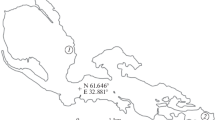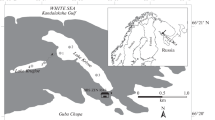Abstract
Quantitative and qualitative changes in the feeding spectra and growth patterns are studied in the larvae and juveniles of perch in artificial water ecosystems (mesocosms) in the presence of a filter-feeding zebra mussel. At a stocking density of 0.75 kg/m2, the presence of a zebra mussel leads to a change in the feeding conditions of zooplankton, to a decrease in its abundance in regards to critical values for fish feeding, to an increase in the abundance of organisms of macrobenthos in the food, and to the rapid transition of the fish to feeding on chironomids. As a result of these changes, the growth rate of perch larvae decreases, their development at step D 1 is delayed, the differentiation of the juveniles by size is accelerated, their size and weight variability increases, and individual predators (cannibals) appear.
Similar content being viewed by others
References
Berezina, N.A. and Strel’nikova, A.P., Relationships between the Food Spectrum of Perch Fry (Perca fluviatilis L.) and the Structure of Zoobenthos in Experimental Mesocosms, Izv. Akad. Nauk, Ser. Biol., 2001, no. 3, pp. 372–379 [Biol. Bull. (Engl. Transl.), 2001, vol. 28, no. 3, pp. 311–318].
Biologicheskie invazii v vodnykh i nazemnykh ekosistemakh (Biological Invasions in Aquatic and Terrestrial Ecosystems), Moscow, 2004.
Borutskii, E.V., Food Resources of Fish, in Materialy po kormovoi baze i pitaniyu ryb (Materials for Food Resources and Nutrition of Fish), Moscow: Akad. Nauk SSSR, 1974, pp. 5–61.
Dgebuadze, Yu.Yu., National Strategy, Status and Trends, Research, Management and Priorities for Invasive Alien Species in Russia, in Amer. Ros. Simp. po Invazionnym Vidam: Tez. Dokl. (Abst. Amer.-Russ. Symp. on Invader Species), Borok, 2001, pp. 38–40.
Ivlev, V.S., Eksperimental’naya ekologiya pitaniya ryb (Experimental Ecology of Fish Feeding), Kiev: Naukova Dumka, 1977.
Il’ina, L.K., Different Quality of Juvenile Perch and Uneven Growth of Scales of Perch (Perca fluviatilis L.) Fingerlings, Vopr. Ikhtiol., 1970, vol. 10, no. 1, pp. 170–175.
Komov, V.T., Natural and Anthropogenic Acidification of Small Lakes in Northwest Russia: Causes, Consequences and Prognosis, Extended Abstract of Doctoral Biol. Dissertation, St. Petersburg, 1999.
Koreneva, E.A., Strel’nikova, A.P., and Umorin, P.P., Effect of Juvenile Fish and Zebra Mussel on the Structure of Zooplankton in the Experimental Mesocosms, Biol. Vnutr. Vod, 2005, no. 3, pp. 67–73.
Kryzhanovskii, S.G., Disler, N.N., and Smirnova, E.N., Ecological and Morphological Patterns of Development of Percoidae, Tr. Inst. Morfol. Zhivotn. im. A.N. Severtsova AN SSSR, Moscow: Akad. Nauk SSSR, 1953, no. 10, pp. 3–139.
Kudrinskaya, O.I., Conditions of Nutrition and Food Supply of Walleye and Perch Larvae in the Upper Part of the Kremenchug Reservoir, in Pishchevye potrebnosti i balans energii u ryb (Food Requirements and Energy Balance in Fish), Kiev: Naukova Dumka, 1973, pp. 183–190.
Kuz’mina, V.V., Latov, V.K., and Poskonova, E.A., Molecular-Mass Characteristics of the Protein Components of Some Food Items of Fish, in Biologiya vnutrennikh vod: Inform. Byul. (Inland Water Biology: Inf. Bull.), Leningrad, 1990, issue 88, pp. 73–77.
Kuz’mina, V.V. and Strel’nikova, A.P., Influence of Circadian Rhythms of Feeding on the Total Amylolytic Activity and Activity of Alkaline Phosphatase in the Intestine of Juvenile Fish, Biol. Vnutr. Vod, 2008, no. 2, pp. 81–90.
Kurbatova, S.A., The Role of the Mollusk Dreissena polymorpha (Pall.) in Water Body and Its Influence on Zooplanktonic Community, Biol. Vnutr. Vod, 1998, no. 1, pp. 39–46.
Kurbatova, S.A., The Response of the Zooplanktonic Communities of Micro- and Mesocosms to Natural and Anthropogenic Factors, Extended Abstract of Cand. Sci. (Biol.) Dissertation: Borok, 2006.
Kurbatova, S.A., Lapteva, N.A., Klain, N.P., and Solntseva, I.O., Effect of Larvae and Yearlings of the Perch (Perca fluviatilis L.) on the Dynamics of Bacterial Communities of Phytoplankton and Zooplankton, in Ozernye ekosistemy: biologicheskie protsessy, antropogennaya transformatsiya, kachestvo vody (Lakustrine Ecosystems: Biological Processes, Anthropogenic Transformation, and Water Quality), Minsk; Belorus. Gos. Univ., 2003, pp. 598–601.
Lakin, G.F., Biometriya (Biometrics), Moscow: Vysshaya Shkola, 1990.
Monakov, A.V., Pitanie presnovodnykh bespozvonochnykh (Feeding of Freshwater Invertebrates), Moscow: Nauka, 1998.
Motyl’ Chironomus plumosus L. Sistematika, morfologiya, ekologiya, produktsiya (Mosquito Chironomus plumosus L. Taxonomy, Morphology, Ecology, and Production), Moscow: Nauka, 1983.
Perova, S.N., Current Status of the Structure of the Community of Benthic Macroinvertebrates in Rybinsk and Gorky Reservoirs, Extended Abstract of Cand. Sci. (Biol.) Dissertation: Borok, 2004.
Polyakov, G.D., Ekologicheskie zakonomernosti populyatsionnoi izmenchivosti ryb (Ecological Patterns of Population Variability of Fish), Moscow: Nauka, 1975.
Primak, R., Osnovy sokhraneniya bioraznoobraziya (Fundamentals of Biodiversity Conservation), Moscow: Izd. Nauch. Uch.-Metod. Tsentra, 2002.
Spanovskaya, V.D. and Grigorash, V.A., Different Quality of Perch Fingerlings, in Fiziologicheskaya i populyatsionnaya ekologiya zhivotnykh (Physiological and Population Ecology of Animals), Saratov, 1980, vol. 6, no. 8, pp. 36–45.
Strel’nikova, A.P., Nutrition and Feeding Relationships of Some Freshwater Fish in Early Ontogeny, Extended Abstract of Cand. Sci. (Biol.) Dissertation, Irkutsk, 1987.
Strel’nikova, A.P., The Mechanism of Switching of Perch Perca fluviatilis L. Fingerlings to a Carnivorous Diet, in Vtoraya Vereshchaginskaya baikal’skaya konf.: Tez. dokl. (Abstr. Second Vereshchagin Baikal Conference), Irkutsk, 1995, pp. 197–198.
Ugolev, A.M. and Kuz’mina, V.V., Pishchevaritel’nye protsessy i adaptatsii u ryb (Digestive Processes and Adaptation in Fish), St. Petersburg: Gidrometeoizdat, 1993.
Khal’ko, V.V., Caloric Level of Plankton in the Rybinsk Reservoir, in Presnovodnye gidrobionty i ikh biologiya (Freshwater Aquatic Organisms and Their Biology), Leningrad: Nauka, 1983, pp. 94–101.
Chirkova, Z.N., On the Distribution and Growth of Perch Fingerlings in the Rybinsk Reservoir, Tr. Biol. St. Borok (Transactions of the Borok Biological Station), 1955, no. 2, pp. 191–199.
Shteinberg, E.A., Feeding of Siberian Roach and Bream Fingerlings in the Krasnoyarsk Reservoir, in Biologicheskie osnovy rybnogo khozyaistva Zapadnoi Sibiri (Biological Basis of Fisheries in Western Siberia), Novosibirsk: Nauka, 1983, pp. 112–114.
Shcherbina, G.Kh., Influence of the Mollusk Dreissena polymorpha (Pall.) on the Structure of Macrozoobenthos of Experimental Mesocosms, Biol. Vnutr. Vod, 2001, no. 1, pp. 63–70.
Shcherbina, G.Kh., Current Distribution, Structure, and Environment-Forming Role of Dreyssenids in Water Bodies of the Northwestern Russia and the Role of Mollusks in the Diet of Benthophagous Fishes, in Dreissenidy: evolyutsiya, sistematika, ekologiya. Mater. 1-oi Mezhdunar. Shk.-Konf. (Proc. 1st Int. School Conf. “Dreissenids: Evolution, Systematics, and Ecology”), Borok, 2008, pp. 23–43.
Horgan, M.J. and Mills, E.L., Zebra Mussel Filter Feeding and Food-Limited Production of Daphnia: Recent Changes in Lower Trophic Level Dynamics of Oneiga Lake, Hydrobiologia, 1999, vol. 411, pp. 78–88.
Mavrin, A.S. and Strelnicova, A.P., The Influence of the Mollusca Filtrator Dreissena polymorpha on Growth and Development of Juvenile Perch Perca fluviatilis L. under Experimental Conditions, in PERCIS II—Second Int. Percid Fish Symp.: Symp. Progr. and Abstracts, Vaasa, 1995, p. 52.
Vinogradov, G.A., Stay, F., Umorin, P.P., et al., The Effect of Heavy Metals and Chlorpyrifos, Separately and in Combination, on a Continuous Flow Mesocosm Aquatic System, Problems of Aquatic Toxicology, Biotesting and Water Quality Management: Proc. Int. Symp., Borok, 1996, pp. 148–161.
Author information
Authors and Affiliations
Corresponding author
Additional information
Original Russian Text © A.S. Mavrin, A.P. Strel’nikova, 2011, published in Biologiya Vnutrennikh Vod, No. 2, 2011, pp. 80–89.
Rights and permissions
About this article
Cite this article
Mavrin, A.S., Strel’nikova, A.P. Feeding, development, and growth of juvenile perch perca fluviatilis in mesocosms in the presence of filter-feeding zebra mussel Dreissena polymorpha pallas. Inland Water Biol 4, 232–241 (2011). https://doi.org/10.1134/S1995082911020143
Received:
Published:
Issue Date:
DOI: https://doi.org/10.1134/S1995082911020143




